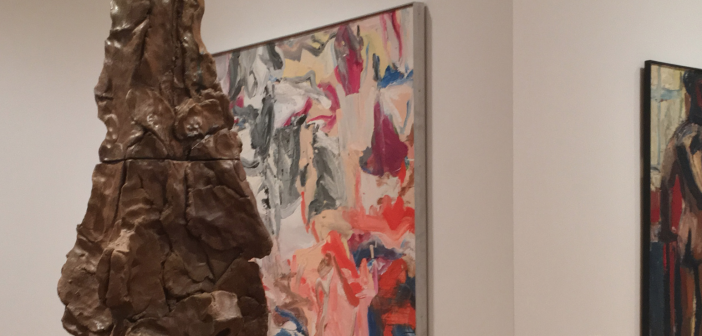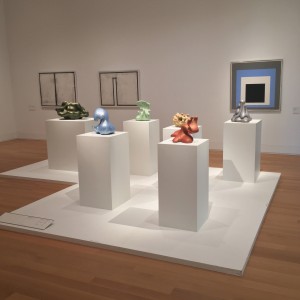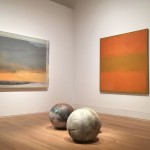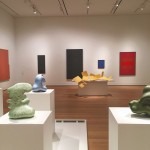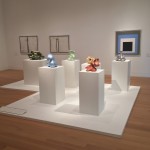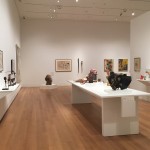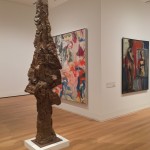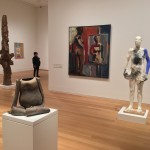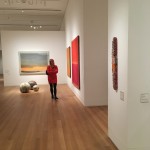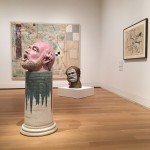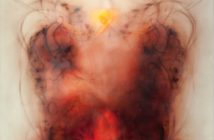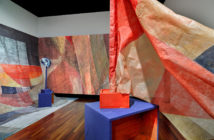A sprawling exhibition adjacent to the permanent display of European Modernism, The Ceramic Presence in Modern Art: Selections from the Linda Leonard Schlenger Collection and the Yale University Art Gallery has a conceptual nexus as simple as its title. Its goal: to situate the work of artists whose primary medium of production is ceramics alongside canonical modernist painting and sculpture. This exhibition is certainly not the first to display artistic practice rooted in craft alongside high-modernist paintings—the anachronistic mash-ups of Renoir, Pennsylvania Dutch metalwork, and Native American ceramics at the Barnes Foundation spring to mind.
Often such installations rely on decorative arts components as visual props intended to draw out viewer’s observations of formal elements present in the paintings. This is not the endeavor of the curators of The Ceramic Presence. Rather, they offer up the perspective that modern and contemporary ceramics, often relegated to the annals of the decorative arts, are of equal artistic merit and deserving of the same scholarly attention as painting and sculpture. In fact, the exhibition catalog claims it is “the first to thoroughly examine postwar ceramic sculpture alongside other fine art of the period.” As the exhibition demonstrates, the selected group of ceramic artists are often in direct dialogue with their contemporaries working in other, more recognized media. Curators Sequoia Miller—a Yale doctoral candidate and studio potter—and Jock Reynolds—Yale University Art Gallery’s Director—make their case in a breathtakingly visual show.
Loosely organized by general themes unobtrusively embedded in the wall text such as “Abstraction to Figuration,” “Biomorphic Abstraction,” and “Abstract Expressionist Ceramics,” the curatorial rhetoric deployed in The Ceramic Presence is one of showing rather than telling. Throughout the exhibition, works are arranged in a way that invites the eye to draw comparisons. Willem de Kooning’s later abstract paintings are consistently placed within the sight-lines of John Mason’s totemic glazed clay sculptures, their roughly hewn, hand-formed surfaces in uncanny harmony with the heavy impasto of de Kooning’s brushwork. The modulating sunset hues of Lynda Benglis’ beeswax and resin painting object, Gift (1972), find striking resonance with the hovering red and orange swaths of Mark Rothko’s neighboring color-field paintings. On the upper floor, Martin Puryear’s spare arch, Stalk (1981), is displayed in concert with Ruth Duckworth’s small sculptures in porcelain, their curving abstract forms and clean white glazes echoing Puryear’s reductionist devotion to purity of form and material. A trio of Peter Voulkos' Untitled Plates are displayed next to Chasi Yukata’s oil on canvas abstraction, Dusk (1957). Clever wall-mounting of Voulkos’ plates mirrors the rounded forms on Yukata’s canvas. With visual parallels everywhere, each room becomes an installation, where the whole is more than the sum of its parts.
Vessels, anti-vessels, and the human body are the three main preoccupations of the included ceramic works. An uncertainty between what constitutes functional object and art object continually simmers beneath the surface. This disquietude is brought to bear in the juxtaposition of works by Ursula von Rydingsvard and Toshiko Takaezu. Von Rydingsvard’s cedar and graphite sculptures, Three Bowls (1989), with their shoulder-height apices, are comically oversized for human use, yet their rough wooden exteriors seem to suggest a hand fabrication that is at odds with an industrial purpose. On low platforms beside Three Bowls rest a duo of egg-shaped glazed ceramic works by Takaezu—scaled for function as an urn or vessel, their sealed tops offer no possibility for practical application.
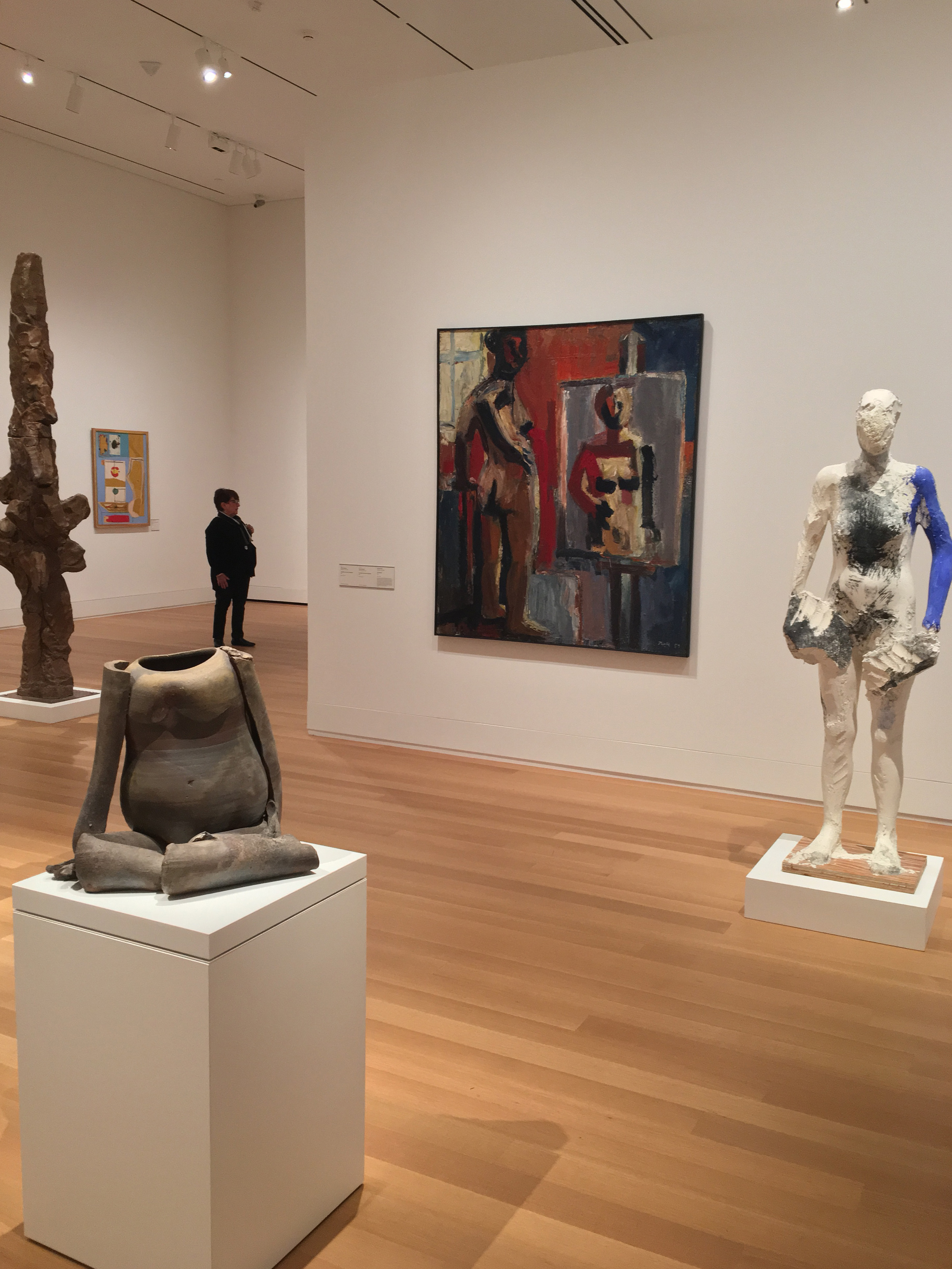
Foreground: 'Lola' by Anthony Caro. Background from left to right: 'Untitled' sculpture by John Mason, 'The Model' by David Park, and 'MJ Series' by Manuel Neri.
For all of its visual enchantment, there are notable absences in The Ceramic Presence, demonstrated eloquently in the few works included by female painters. While works by male painters (including Jackson Pollock, Arshile Gorky, Mark Rothko, and Barnett Newman) were prominently featured, only a single painting by the well-known female abstract expressionist Helen Frankenthaler was displayed and not one by Elaine de Kooning or Lee Krasner. A quick tally revealed that only around 9% of the selected paintings and 23% of the 3-D works were made by women. It is troubling that an exhibition attempting to author a more inclusive history of the modernist pantheon would neglect to include these female artists. Indeed, the omission of so many important female artists makes clear a broader issue: that the matrix into which the ceramic works were dropped remains unchallenged. The exhibition’s concept might have been better served if the curators chose to question the status-quo of canonized modernism more broadly, rather than offering an addendum that includes ceramics. It is a pandora’s box that Miller and Reynolds chose to leave unopened, but it causes us to question the many other gaps in the accepted history of modern art. Despite its oversights, The Ceramic Presence remains a compelling exhibition. It is not often, in our image-saturated present, that are we are so skillfully invited to take a moment to re-calibrate our visual attention, and, in the words of Anne d’Harnoncourt, invited “to look and look and look, and then to look again.”¹
The Ceramic Presence in Modern Art: Selections from the Linda Leonard Schlenger Collection and the Yale University Art Gallery is on view at the Yale University Art Gallery through January 3, 2016.
------------------------------------------------------------------------------------------------------------------------------------------------------
1. Obrist, Hans U, and Lionel Bovier. A Brief History of Curating. Zurich: JRP / Ringier, 2008. Print.
- Ceramics by Toshiko Takaezu at center, Mark Rothko painting at right.
- Ceramic works by Kenneth price displayed in concert with sculpture by Anthony Caro, and restrained geometric abstraction by Robert Mangold, Frank Stella, and Ad Reinhardt.
- Six ceramic works by Kenneth Price at foreground, Joseph Albers Homage to the Square at rear.
- Installation view of one gallery.
- Untitled glazed clay sculpture by John Mason positioned next to large late painting by Willem de Kooning.
- Foreground: ‘Lola’ by Anthony Caro. Background from left to right: ‘Untitled’ sculpture by John Mason, ‘The Model’ by David Park, and ‘MJ Series’ by Manuel Neri.
- ‘Gift’ by Lynda Benglis (1972) at foreground with paintings by Mark Rothko and ceramic works by Toshiko Takaezu.
- Two self-portrait busts by Robert Arneson and painting by William T. Wiley

